-
 Bitcoin
Bitcoin $108,489.6704
1.13% -
 Ethereum
Ethereum $2,502.0528
2.92% -
 Tether USDt
Tether USDt $1.0002
0.00% -
 XRP
XRP $2.1941
0.51% -
 BNB
BNB $655.3375
1.00% -
 Solana
Solana $151.5977
1.27% -
 USDC
USDC $0.9999
0.00% -
 TRON
TRON $0.2768
0.32% -
 Dogecoin
Dogecoin $0.1676
2.86% -
 Cardano
Cardano $0.5675
0.98% -
 Hyperliquid
Hyperliquid $40.6109
7.48% -
 Bitcoin Cash
Bitcoin Cash $500.7746
2.09% -
 Sui
Sui $2.8328
2.03% -
 Chainlink
Chainlink $13.4452
1.26% -
 UNUS SED LEO
UNUS SED LEO $9.1623
0.39% -
 Avalanche
Avalanche $18.2267
2.24% -
 Stellar
Stellar $0.2382
0.00% -
 Toncoin
Toncoin $2.8885
1.68% -
 Shiba Inu
Shiba Inu $0.0...01159
0.91% -
 Litecoin
Litecoin $87.1827
0.88% -
 Hedera
Hedera $0.1511
2.90% -
 Monero
Monero $315.4992
-0.59% -
 Polkadot
Polkadot $3.4663
2.34% -
 Bitget Token
Bitget Token $4.6118
-0.65% -
 Dai
Dai $1.0000
-0.01% -
 Ethena USDe
Ethena USDe $1.0003
0.02% -
 Uniswap
Uniswap $7.2989
4.69% -
 Pepe
Pepe $0.0...01003
5.73% -
 Aave
Aave $275.5616
7.15% -
 Pi
Pi $0.5181
-2.49%
What does the shrinking trading volume of Jupiter (JUP) mean? Should I reduce my position and wait and see?
Shrinking trading volume of JUP may signal reduced interest or consolidation; investors should assess their strategy, considering holding, reducing, or adopting a wait-and-see approach.
May 06, 2025 at 12:14 am
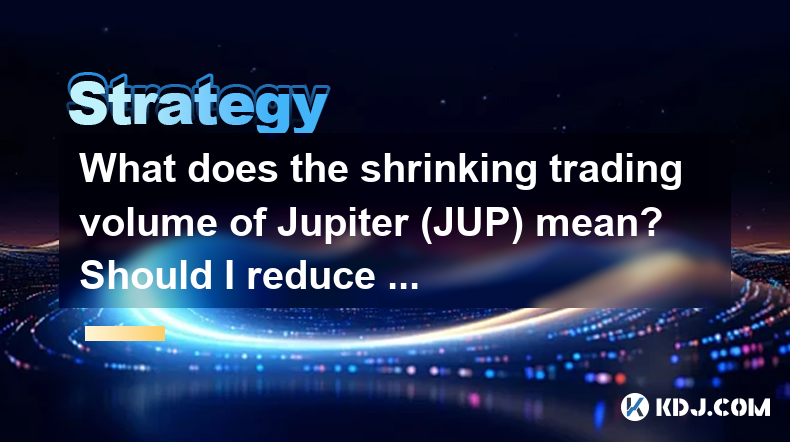
The phenomenon of shrinking trading volume for Jupiter (JUP), a popular cryptocurrency, can have several implications for investors and traders. Understanding what this trend signifies and how to react to it can be crucial for making informed decisions about your investment strategy. This article will delve into the possible meanings behind the shrinking trading volume of JUP, explore whether it's advisable to reduce your position, and provide insights into what a "wait and see" approach might entail.
Understanding Trading Volume in Cryptocurrency
Trading volume represents the total number of shares or units of a cryptocurrency traded within a specific timeframe. It is a critical indicator of a cryptocurrency's liquidity and market activity. For Jupiter (JUP), a shrinking trading volume suggests that fewer traders are actively buying and selling the token. This could be due to various factors such as market sentiment, regulatory news, or shifts in investor interest.
Possible Meanings of Shrinking Trading Volume
When the trading volume of JUP decreases, it can indicate several things. Firstly, it might reflect a lack of interest in the cryptocurrency, possibly due to negative news or a shift in investor focus to other assets. Secondly, it could signify a period of consolidation where the price is stabilizing after a significant move. Lastly, it might be a precursor to a larger price movement, as low volume can sometimes precede a breakout or breakdown.
Should You Reduce Your Position?
Deciding whether to reduce your position in JUP when its trading volume shrinks depends on your investment goals and risk tolerance. If you are a long-term investor with a strong belief in the fundamentals of JUP, you might choose to hold your position, viewing the decreased volume as a temporary market condition. However, if you are a short-term trader or someone who relies on liquidity for quick trades, reducing your position might be a prudent move to avoid potential volatility.
The Wait and See Approach
Adopting a "wait and see" approach involves monitoring the market closely without making immediate changes to your position. This strategy can be beneficial if you believe that the current low volume is a temporary phenomenon and that JUP might regain its momentum. During this period, it's crucial to stay informed about market news, analyze technical indicators, and keep an eye on overall market trends to make a more informed decision later.
How to Monitor and Analyze JUP's Trading Volume
To effectively monitor and analyze the trading volume of JUP, you can follow these steps:
- Choose a Reliable Trading Platform: Use a reputable cryptocurrency exchange or trading platform that provides real-time data on JUP's trading volume.
- Set Up Alerts: Configure alerts to notify you of significant changes in trading volume, which can help you stay updated without constantly monitoring the market.
- Use Technical Analysis Tools: Employ tools like moving averages, volume indicators, and chart patterns to understand the context of the volume changes.
- Review Historical Data: Compare current volume levels with historical data to determine if the current trend is unusual or within normal fluctuations.
Impact of Market Sentiment on JUP's Trading Volume
Market sentiment plays a significant role in influencing the trading volume of cryptocurrencies like JUP. Positive sentiment can drive more investors to buy JUP, increasing its trading volume. Conversely, negative sentiment can lead to a decrease in trading activity as investors might choose to sell or hold off on buying. Monitoring sentiment through social media, news outlets, and community forums can provide valuable insights into potential volume changes.
Liquidity and Its Effect on Trading Volume
Liquidity is another crucial factor to consider when analyzing the shrinking trading volume of JUP. High liquidity typically results in higher trading volumes, as there are more buyers and sellers in the market. Low liquidity, on the other hand, can lead to decreased trading volumes, making it harder to buy or sell large amounts of JUP without affecting its price. Understanding the liquidity of JUP can help you better interpret the significance of its trading volume changes.
Strategies for Managing Your JUP Position
Given the shrinking trading volume of JUP, here are some strategies you might consider to manage your position:
- Diversify Your Portfolio: If you're concerned about the low volume of JUP, consider diversifying your investments into other cryptocurrencies or assets to mitigate risk.
- Set Stop-Loss Orders: Implement stop-loss orders to automatically sell your JUP if its price drops to a certain level, helping you limit potential losses.
- Reassess Your Investment Thesis: Take the time to review the reasons behind your initial investment in JUP and see if those factors still hold true given the current market conditions.
- Consider Dollar-Cost Averaging: If you believe in the long-term potential of JUP, you might continue to invest smaller amounts periodically to average out your cost over time.
Frequently Asked Questions
Q: How can I tell if the shrinking trading volume of JUP is a short-term or long-term trend?
A: To determine whether the shrinking trading volume of JUP is a short-term or long-term trend, you should analyze the volume over an extended period. Look at weekly and monthly volume data to see if the current low volume is an anomaly or part of a longer trend. Additionally, consider external factors such as market news and overall cryptocurrency market trends.
Q: Can the shrinking trading volume of JUP affect its price stability?
A: Yes, the shrinking trading volume of JUP can impact its price stability. Lower trading volumes often result in reduced liquidity, which can lead to increased price volatility. With fewer buyers and sellers in the market, even small trades can cause significant price movements.
Q: Is it possible for JUP's trading volume to increase again after a period of decline?
A: Yes, it is possible for JUP's trading volume to increase after a period of decline. Factors such as positive news, new developments within the JUP ecosystem, or a general increase in market interest can lead to a resurgence in trading activity.
Q: How can I use trading volume data to make better trading decisions for JUP?
A: You can use trading volume data to make better trading decisions for JUP by combining it with other technical indicators. For instance, if you notice a significant increase in volume alongside a price breakout, it could signal strong market interest and a potential trend continuation. Conversely, if the price moves without a corresponding increase in volume, it might indicate a weaker trend. Always consider volume in the context of other market data to enhance your decision-making process.
Disclaimer:info@kdj.com
The information provided is not trading advice. kdj.com does not assume any responsibility for any investments made based on the information provided in this article. Cryptocurrencies are highly volatile and it is highly recommended that you invest with caution after thorough research!
If you believe that the content used on this website infringes your copyright, please contact us immediately (info@kdj.com) and we will delete it promptly.
- Bitcoin's Bumpy Ride: Profit-Taking Slows Momentum, What's Next?
- 2025-06-30 20:30:11
- Bitcoin's Price Stall: Decoding the ETF Inflows Mystery
- 2025-06-30 20:30:11
- Ripple XRP, Bitcoin, and Solaris Presale: What's the Buzz?
- 2025-06-30 18:50:11
- SpaceX, Mirror Tokens, and Investors: A Wild Ride to the Future?
- 2025-06-30 19:10:22
- Arbitrum (ARB) and Robinhood: Partnership Rumors Fuel Price Surge to $0.4289?
- 2025-06-30 19:10:22
- Jasmy Coin, Bitcoin, and the Rise of Solaris Presale: What's the Buzz?
- 2025-06-30 18:30:12
Related knowledge
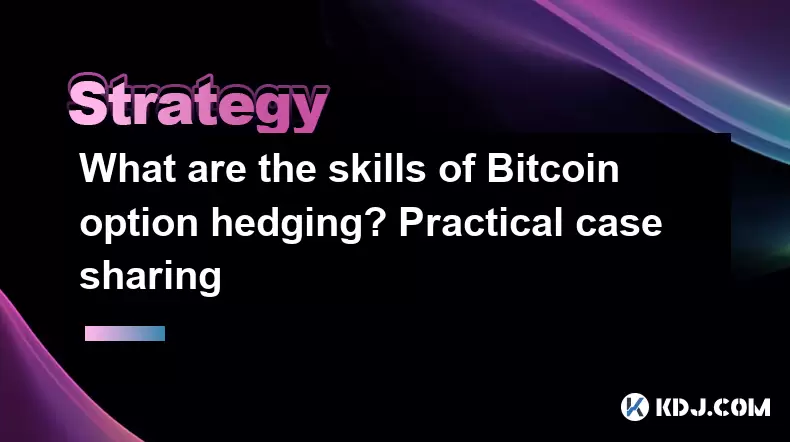
What are the skills of Bitcoin option hedging? Practical case sharing
Jun 24,2025 at 04:01pm
Understanding Bitcoin Option HedgingBitcoin option hedging is a risk management strategy used by traders and investors to protect their positions in the volatile cryptocurrency market. By using options, individuals can limit potential losses while retaining the opportunity for profit. In essence, it allows one to insulate against adverse price movements...
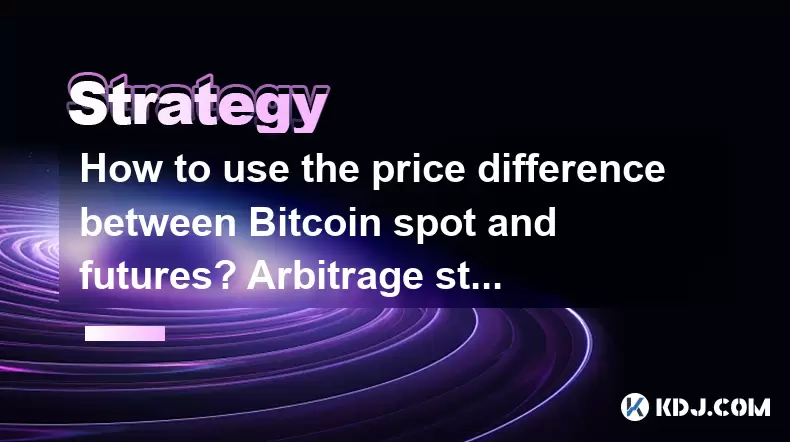
How to use the price difference between Bitcoin spot and futures? Arbitrage strategy
Jun 20,2025 at 02:56pm
Understanding Bitcoin Spot and Futures MarketsTo effectively leverage arbitrage opportunities between Bitcoin spot and futures markets, it's essential to understand the fundamental differences between these two types of markets. The spot market refers to the direct buying and selling of Bitcoin for immediate delivery at the current market price. In cont...
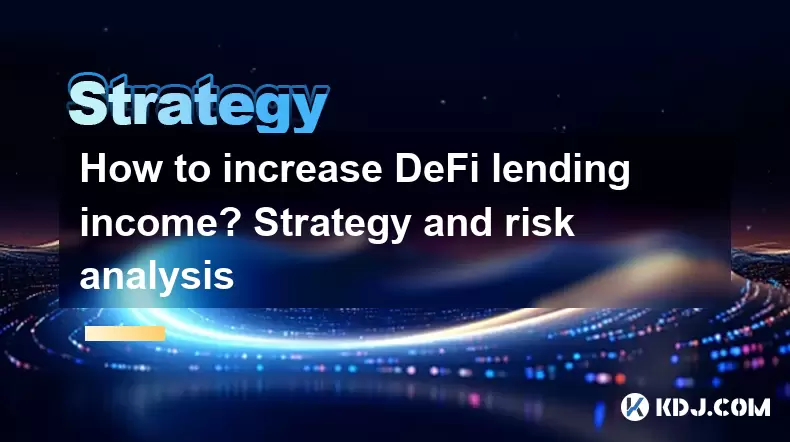
How to increase DeFi lending income? Strategy and risk analysis
Jun 24,2025 at 02:08pm
Understanding DeFi Lending and Its Income PotentialDeFi (Decentralized Finance) lending has emerged as a popular way to earn passive income in the cryptocurrency space. Unlike traditional banking systems, DeFi lending platforms allow users to lend their crypto assets directly to borrowers without intermediaries. The lenders earn interest based on the su...
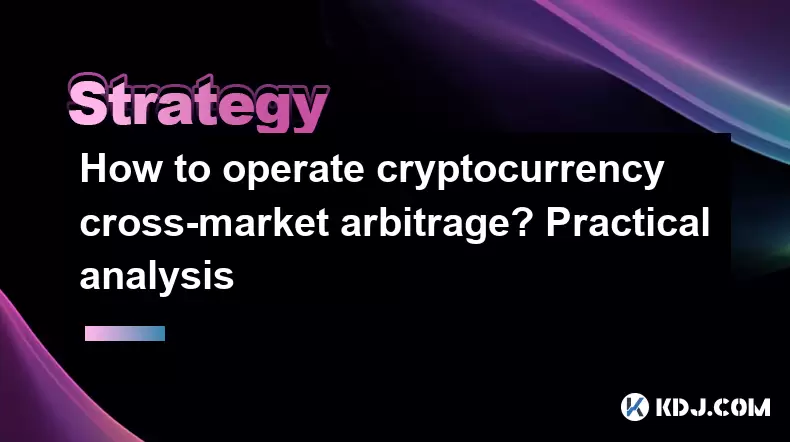
How to operate cryptocurrency cross-market arbitrage? Practical analysis
Jun 23,2025 at 04:01am
Understanding Cryptocurrency Cross-Market ArbitrageCryptocurrency cross-market arbitrage involves taking advantage of price differences for the same digital asset across different exchanges. The core idea is to buy low on one exchange and sell high on another, capturing the profit from the discrepancy. This strategy relies heavily on real-time market da...

How to make profits from high-frequency cryptocurrency trading? Sharing core skills
Jun 19,2025 at 05:07pm
Understanding High-Frequency Cryptocurrency TradingHigh-frequency trading (HFT) in the cryptocurrency market involves executing a large number of trades at extremely fast speeds, often within milliseconds. This method relies on small price discrepancies across exchanges or within a single exchange’s order book. Traders use complex algorithms and ultra-l...

What are the methods of cryptocurrency quantitative trading? Detailed analysis
Jun 22,2025 at 11:07pm
Understanding the Core of Cryptocurrency Quantitative TradingCryptocurrency quantitative trading refers to the use of mathematical models and algorithms to execute trades in the digital asset market. Unlike traditional discretionary trading, which relies heavily on human judgment, quantitative trading leverages data-driven strategies to identify profita...

What are the skills of Bitcoin option hedging? Practical case sharing
Jun 24,2025 at 04:01pm
Understanding Bitcoin Option HedgingBitcoin option hedging is a risk management strategy used by traders and investors to protect their positions in the volatile cryptocurrency market. By using options, individuals can limit potential losses while retaining the opportunity for profit. In essence, it allows one to insulate against adverse price movements...

How to use the price difference between Bitcoin spot and futures? Arbitrage strategy
Jun 20,2025 at 02:56pm
Understanding Bitcoin Spot and Futures MarketsTo effectively leverage arbitrage opportunities between Bitcoin spot and futures markets, it's essential to understand the fundamental differences between these two types of markets. The spot market refers to the direct buying and selling of Bitcoin for immediate delivery at the current market price. In cont...

How to increase DeFi lending income? Strategy and risk analysis
Jun 24,2025 at 02:08pm
Understanding DeFi Lending and Its Income PotentialDeFi (Decentralized Finance) lending has emerged as a popular way to earn passive income in the cryptocurrency space. Unlike traditional banking systems, DeFi lending platforms allow users to lend their crypto assets directly to borrowers without intermediaries. The lenders earn interest based on the su...

How to operate cryptocurrency cross-market arbitrage? Practical analysis
Jun 23,2025 at 04:01am
Understanding Cryptocurrency Cross-Market ArbitrageCryptocurrency cross-market arbitrage involves taking advantage of price differences for the same digital asset across different exchanges. The core idea is to buy low on one exchange and sell high on another, capturing the profit from the discrepancy. This strategy relies heavily on real-time market da...

How to make profits from high-frequency cryptocurrency trading? Sharing core skills
Jun 19,2025 at 05:07pm
Understanding High-Frequency Cryptocurrency TradingHigh-frequency trading (HFT) in the cryptocurrency market involves executing a large number of trades at extremely fast speeds, often within milliseconds. This method relies on small price discrepancies across exchanges or within a single exchange’s order book. Traders use complex algorithms and ultra-l...

What are the methods of cryptocurrency quantitative trading? Detailed analysis
Jun 22,2025 at 11:07pm
Understanding the Core of Cryptocurrency Quantitative TradingCryptocurrency quantitative trading refers to the use of mathematical models and algorithms to execute trades in the digital asset market. Unlike traditional discretionary trading, which relies heavily on human judgment, quantitative trading leverages data-driven strategies to identify profita...
See all articles

























































































